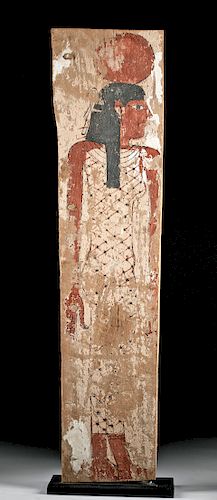Egyptian Painted Cedar / Gesso Coffin Panel - Nut
Lot 20a
About Seller
Artemis Fine Arts
686 S Taylor Ave, Ste 106
Louisville, CO 80027
United States
Selling antiquities, ancient and ethnographic art online since 1993, Artemis Gallery specializes in Classical Antiquities (Egyptian, Greek, Roman, Near Eastern), Asian, Pre-Columbian, African / Tribal / Oceanographic art. Our extensive inventory includes pottery, stone, metal, wood, glass and textil...Read more
Estimate:
$10,000 - $15,000
Absentee vs Live bid
Two ways to bid:
- Leave a max absentee bid and the platform will bid on your behalf up to your maximum bid during the live auction.
- Bid live during the auction and your bids will be submitted real-time to the auctioneer.
Bid Increments
| Price | Bid Increment |
|---|---|
| $0 | $25 |
| $300 | $50 |
| $1,000 | $100 |
| $2,000 | $250 |
| $5,000 | $500 |
| $10,000 | $1,000 |
| $20,000 | $2,500 |
| $50,000 | $5,000 |
| $100,000 | $10,000 |
| $200,000 | $20,000 |
About Auction
By Artemis Fine Arts
Sep 26, 2019
Set Reminder
2019-09-26 10:00:00
2019-09-26 10:00:00
America/New_York
Bidsquare
Bidsquare : Exceptional Day 1: Antiquities & Asian Art
https://www.bidsquare.com/auctions/artemis-gallery/exceptional-day-1-antiquities-asian-art-4437
Day 1 of an important 2-day auction featuring exceptional, museum-worthy examples of Egyptian, Greek, Etruscan, Roman, Viking, Russian, Near Eastern, as well as Asian Art from China, Japan, Thailand, Vietnam, Burma and India. Artemis Fine Arts info@artemisgallery.com
Day 1 of an important 2-day auction featuring exceptional, museum-worthy examples of Egyptian, Greek, Etruscan, Roman, Viking, Russian, Near Eastern, as well as Asian Art from China, Japan, Thailand, Vietnam, Burma and India. Artemis Fine Arts info@artemisgallery.com
- Lot Description
Egypt, Late Dynastic to Ptolemaic Period, ca. 664 to 30 BCE. A gorgeous hand-carved cedar wood coffin panel of a lengthy rectangular form. One lateral periphery bears two slender mortises, and the other exhibits remains of dowel fragments in each of the four dowel holes. The obverse side - which would have been an interior coffin wall - is covered in chalky white gesso and painted with in vivid white, red, and black hues that comprise an effigy of Nut (from the Egyptian Nwt), the goddess of the sky, stars, and rebirth. Nut stands with draped arms and a rigid posture, wears a netted dress and concentric necklaces, and has a knotted sash in her hair. Her visage is composed of almond-shaped eyes with elongated canthi, full lips, and a masculine jawline, and her neatly arranged coiffure is draped to her breast and surmounted by a red sun disk. Egyptian coffins featured images of Nut to aid the deceased in the process of resurrection. Size: 10.5" W x 42.6" H (26.7 cm x 108.2 cm); 43.1" H (109.5 cm) on included custom stand.
This depiction features a sun disk above Nut's head surmounted by a band of dark pigment, likely symbolizing the sky as Nut (also Nunut, Nuit) was the goddess and personification of the Sky and the celestial realm. She is regarded as the barrier separating the ordered cosmos of the world from the forces of chaos. In some depictions, Nut was portrayed as a woman arched on her toes and fingertips over the earth; her sacred body representing a star-filled sky. Nut's fingers and toes as such were believed to touch the four cardinal directions: north, south, east, and west. According to Egyptian mythology, Nut is a daughter of Shu ("he who rises up" or the personification of air) and Tefnut (goddess of moisture, dew, and rain); her husband and brother is Geb (god of the earth, father of snakes, whose laughter could bring about earthquakes and fertile crops), and she has four children: Osiris, Set, Isis, and Nephthys. Nut was also granddaughter of Ra or Atum, the creator god. The Coffin Texts describe Nut as "she of the braided hair who bore the gods". In one fascinating myth, Nut gives birth to the Sun-god each day, and he passes over her body during the day only to be swallowed at night and reborn the next morning.
Interestingly, cedar wood was not native to Egypt. Egypt did not have verdant forests filled with tall trees, and unfortunately most of its native lumber was of relatively poor quality. Thus, they relied on importing to acquire hardwoods - ebony imported from Africa, cedar and pine from Lebanon. One fabulous obelisk inscription by Thutmose III attests to the luxury of treasured hardwoods. It reads as follows, "They brought to me the choicest products...consisting of cedar, juniper and of meru wood...all the good sweet woods of God's Land." The rarity of cedar meant that coffin panels like this example were reserved for those who could afford them.
An example of a wooden sarcophagus panel featuring Nut, of a larger size, hammered for $31,200 at Christie's, New York "Antiquities" auction (sale 1846, June 8, 2007, lot 27): https://www.christies.com/lotfinder/lot/an-egyptian-painted-wood-sarcophagus-panel-late-4921141-details.aspx?from=searchresults&intObjectID=4921141&sid=d6b403cf-8f67-4794-af36-d426462936b8
Provenance: private Pennsylvania, USA collection; ex-William Ashby estate collection
All items legal to buy/sell under U.S. Statute covering cultural patrimony Code 2600, CHAPTER 14, and are guaranteed to be as described or your money back.
A Certificate of Authenticity will accompany all winning bids.
We ship worldwide and handle all shipping in-house for your convenience.
#148952This is a panel from a larger wooden coffin. Minor chips to corners, peripheries, and original pigmentation on obverse, with several stable fissures that do not threaten the integrity of the composition, and light encrustations, otherwise intact and excellent. Nice earthen deposits throughout, and great original pigment remains on obverse.Condition
- Shipping Info
-
All shipping is handled in-house for your convenience. Your invoice from Artemis Gallery will include shipping calculation instructions. If in doubt, please inquire BEFORE bidding for estimated shipping costs for individual items.
-
- Buyer's Premium



 EUR
EUR CAD
CAD AUD
AUD GBP
GBP MXN
MXN HKD
HKD CNY
CNY MYR
MYR SEK
SEK SGD
SGD CHF
CHF THB
THB














